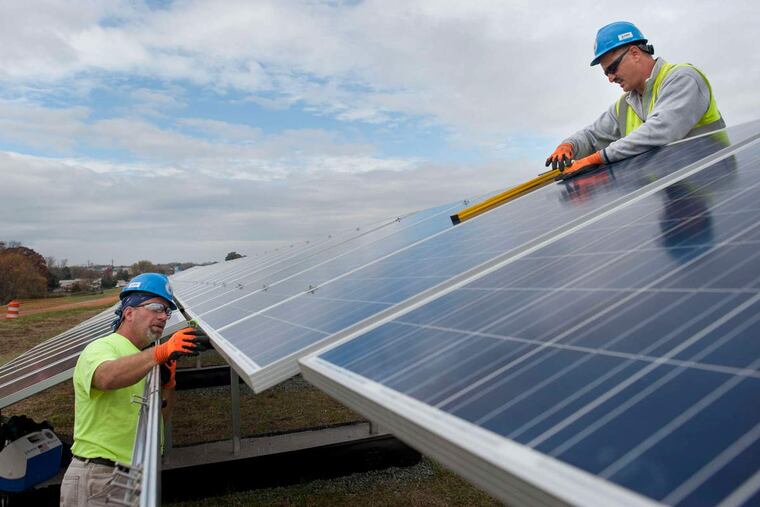Solar farm at L&D Landfill operating fully
The last of nearly 200 electricians and laborers at a Mount Holly landfill finished last week, leaving behind a sprawling solar farm that will capture the sun's rays and convert them into energy.

The last of nearly 200 electricians and laborers at a Mount Holly landfill finished last week, leaving behind a sprawling solar farm that will capture the sun's rays and convert them into energy.
The solar farm atop the former L&D Landfill has begun silently churning out about 12.9 megawatts of energy. That's enough electricity to power about 2,000 homes, PSE&G officials say.
"It's our largest solar farm in New Jersey," said Todd Hranicka, director of Solar Energy for the utility company, as rows and rows of 42,000 panels were being installed on a gray day last month. In recent days, a direct "interconnection" was made between the panels and the grid.
Francis Sullivan, a PSE&G spokesman, said the solar farm is in full operation and "only needs maintenance every six months." Snow, rain and wind typically do not create any problems for the panels, but minor adjustments may need to be made, he said.
The interconnection was performed by linking the wires in the solar panels to a line of wires underground that travel up a single utility pole at the edge of the site, Sullivan said. The solar energy directly enters the grid, he said, mingling with the current traveling into peoples' homes.
"It's hard to say exactly where the electrons go, exactly, but they would go into homes in the surrounding area," in Burlington County, Sullivan said. There's no storage system, so the amount generated depends on how sunny the day is and also the length of the day, he said. The output is also calculated by considering the amount of solar power generated by each panel, the average amount of electricity used per household, and other factors, Sullivan said.
The L&D project is the fourth that PSE&G has built on a landfill. The projects have grown in size, Hranicka said, noting that the first one, located on a landfill in Kearney, generates only three megawatts of electricity. The others are at the Parklands Landfill in Bordentown and the Kinsley Landfill in Deptford, and generate 10.13 and 11.18 megawatts, respectively.
The 200-acre L&D Landfill, which straddles Mount Holly, Eastampton and Lumberton Townships, had presented PSE&G with a special challenge because it was once listed as a Superfund site and deemed one of the most contaminated in the country. The sea of solar panels had to be anchored to concrete ballasts so that the landfill's protective cap would not be pierced.
Once a sand and gravel pit in the early 1940s, the landfill later was used as a dump for demolition debris, municipal trash and industrial waste. Sewage sludge also was treated on-site. Since then, collection systems were installed to capture pollutants and methane gas. The pumps are still operating.
PSE&G used only a 53-acre section of the landfill for this project but is considering expanding into another area of the landfill in the future, Sullivan said.
Currently, there are a total of eight landfills in New Jersey with solar farms, according to Larry Hajna, a spokesman with the state Department of Environmental Protection. Among them is the solar farm built atop the Pennsauken Landfill in Camden County and visible from the lanes on the Betsy Ross Bridge. It generates 2.1 megawatts of power.
Hajna said three other solar projects on landfills have been proposed and are in various stages of development. They include a landfill on Delilah Road in Egg Harbor Township, in Atlantic County, and two in North Jersey. The one on Delilah Road also was on the Superfund program's National Priorities List because it was considered hazardous. When completed, it is expected to generate 11.5 megawatts of electricity.
856-779-3224 @JanHefler